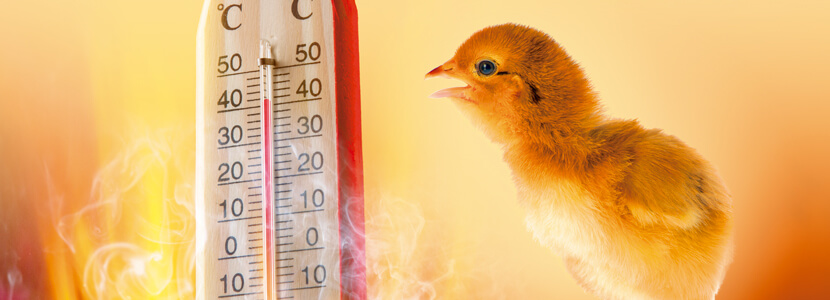Heat stress represents a major challenge for maintaining health and performance levels within the poultry industry.
Introduction
Global consumption of poultry products such as meat and eggs has doubled in the past decade and is expected to be doubled by 2050. Poultry meat contains low amounts of saturated fatty acids and is rich in protein, vitamins, and minerals. Poultry eggs are one of the most affordable sources of animal protein, and besides their content of vitamins, minerals, and proteins, they are also rich in antioxidants such as lutein and zeaxanthin. Offering significant eye health benefits. Therefore, global demands on poultry products have significantly increased, and will most likely continue to do so.
In response to such demands, there have been great improvements in chicken genetics during the past decade. Broiler chickens, which weighed around 900 g in 56 days in the 1950s, were around 4202 g in 2005. Similarly, laying hens in the early 1900s used to lay 150 eggs per year while current commercial laying hens lay around 300 eggs annually . Such genetical improvements in broilers and laying hens, have also brought upon higher metabolic rates and production performances in these animals. The higher metabolic rates of these animals generate larger amounts of body heat, making them much more susceptible to heat stress. The risk of heat stress in poultry is made even worse due to current rearing conditions with high stocking density of birds, along with high environmental temperatures.
Heat stress is one of the major environmental stressors in the poultry industry resulting in substantial economic loss. It causes several physiological changes, such as oxidative stress, acid-base imbalance, and suppressed immunocompetence. Leading to increased mortality and reduced feed efficiency, body weight, feed intake, and egg production. While also affecting meat and egg quality.
As of 2003, the poultry industry suffered annual economic losses of $128 to $165 million, due to the negative impacts of heat stress. When subjected to this extreme condition, birds are unable to maintain a physiological balance between body heat production and heat loss. This condition involves the interaction of several factors such as:
- high environmental temperature
- humidity
- radiant heat
- and airspeed
The normal body temperature of chickens ranges around 41–42 °C. Meanwhile, the thermoneutral temperature to maximize growth ranges between 18–21 °C . Studies have shown that any environmental temperature higher than 25 °C can cause heat stress in poultry. There is extensive scientific literature covering the negative impacts of heat stress on poultry health and performance. There is also a significant amount of studies carried out in search of potential mitigation strategies.
This article aims to review some of the most relevant published information regarding the physiological and behavioral changes seen in poultry when subjected to heat stress, as well as mentioning (2) potential mitigation strategies for broilers and laying hens.
Biological changes in poultry associated with heat stress
Source:(Wasti, S.; Sah, N.; Mishra, B. 2020)
Oxidative Stress
Acid-base imbalance
Suppressed Immune function
- spleen,
- thymus,
- and lymphoid organs
Potential nutritional strategies for mitigating heat stress in poultry
The following are just some examples of nutritional strategies, from the many existing ones that have been developed and tested to counter heat stress in poultry production.
Feed Restriction
Dual feeding regime
Wet feeding
- Heat stress has become a major challenge affecting the development of the poultry industry during the last decade. This scenario has become even more complicated due to rising global temperatures.
- Heat stress in poultry results from the interplay of several factors, such as: high environmental temperatures, humidity, radiant heat, and airspeed. Causing significant physiological, neuroendocrine, and behavioral changes in the animals.
- Several strategies have been set forth and tested to mitigate the deleterious effects of heat stress in poultry. However, only a few of these are widely implemented within the poultry industry.
- Due to its multifactorial nature, single strategy approaches are not effective at counteracting the negative impacts of heat-stress on poultry. Therefore, a holistic approach towards heat stress mitigation in poultry is required.
- The use of nutritional strategies, modifications in housing and management should all prove to be beneficial in mitigating heat stress. However, greater research evaluating the combination different approaches to counteract heat-stress in poultry is still needed. In order to evaluate the efficiency of such combinations and assess their cost to benefit relation.
